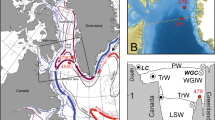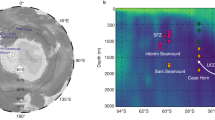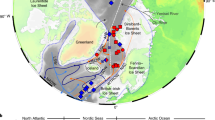Abstract
A period of cooling about 13,000 years ago interrupted about 2,000 years of deglacial warming. Known as the Younger Dryas (YD), the event is thought to have resulted from a slowdown of the Atlantic meridional overturning circulation in response to a sudden flood of Laurentide Ice Sheet meltwater that reached the Nordic Seas. Oxygen isotope evidence for a local source of meltwater to the open western North Atlantic from the Gulf of St Lawrence has been lacking. Here we report that the eastern Beaufort Sea contains the long-sought signal of 18O-depleted water. Beginning at ~12.94 ± 0.15 thousand years ago, oxygen isotopes in the planktonic foraminifera from two sediment cores as well as sediment and seismic data indicate a flood of meltwater, ice and sediment to the Arctic via the Mackenzie River that lasted about 700 years. The minimum in the oxygen isotope ratios lasted ~130 years. We suggest that the floodwater travelled north along the Canadian Archipelago and then through the Fram Strait to the Nordic Seas, where freshening and freezing near sites of deep-water formation would have suppressed convection and caused the YD cooling by reducing the meridional overturning.
This is a preview of subscription content, access via your institution
Access options
Access Nature and 54 other Nature Portfolio journals
Get Nature+, our best-value online-access subscription
$29.99 / 30 days
cancel any time
Subscribe to this journal
Receive 12 print issues and online access
$259.00 per year
only $21.58 per issue
Buy this article
- Purchase on SpringerLink
- Instant access to full article PDF
Prices may be subject to local taxes which are calculated during checkout





Similar content being viewed by others
References
Dickson, R. R., Meincke, J., Malmberg, S. A. & Lee, A. J. The ‘Great Salinity Anomaly’ in the Northern North Atlantic 1968–1982. Prog. Oceanogr. 20, 103–151 (1988).
Aagard, K. & Carmack, E. The role of sea ice and other fresh water in the Arctic circulation. J. Geophys. Res. 94, 14485–14498 (1989).
Häkkinen, S. An Arctic source for the great salinity anomaly: a simulation of the Arctic ice-ocean system for 1955-1975. J. Geophys. Res. 98, 16397–16410 (1993).
Kennett, J. P. & Shackleton, N. J. Laurentide ice sheet meltwater recorded in Gulf of Mexico deep-sea cores. Science 188, 147–150 (1975).
Williams, C., Flower, B. & Hastings, D. W. Seasonal Laurentide ice sheet melting during the ‘Mystery Interval’ (17.5–14.5 ka). Geology 40, 955–958 (2012).
Keigwin, L. D. & Jones, G. A. The marine record of deglaciation from the continental margin off Nova Scotia. Paleoceanography 10, 973–985 (1995).
de Vernal, A., Hillaire-Marcel, C. & Bilodeau, G. Reduced meltwater outflow from the Laurentide ice margin during the Younger Dryas. Nature 381, 774–777 (1996).
Keigwin, L. D., Sachs, J., Rosenthal, Y. and Boyle, E. A. The 8200 year B.P. event in the slope water system, western subpolar North Atlantic. Paleoceanography 20, PA2003 (2005).
Broecker, W. S. et al. The routing of meltwater from the Laurentide ice-sheet during the Younger Dryas cold episode. Nature 341, 318–321 (1989).
Muschitiello, F. et al. Fennoscandian freshwater control on Greenland hydroclimate shifts at the onset of the Younger Dryas. Nat. Commun. 6, 8939 (2015).
Brauer, A. et al. An abrupt wind shift in western Europe at the onset of the Younger Dryas cold period. Nat. Geosci. 1, 520–523 (2008).
Renssen, H. et al. Multiple causes of the Younger Dryas cold period. Nat. Geosci. 8, 946–950 (2015).
Andersson, G. Swedish Vegetation History (P.A. Norstedt & Soners, Stockholm, 1897).
Hartz, N. & Milthers, V. The late glacial clay in the Allerod brickyard. Medd. Dan. Geol. Foren. 8, 31–60 (1901).
Mangerud, J., Andersen, S. T., Berglund, B. E. & Donner, J. J. Quaternary stratigraphy of Norden, a proposal for terminology and classification. Boreas 3, 110–127 (1974).
Johnson, R. G. & McClure, B. T. A model for northern hemisphere continental ice sheet variation. Quat. Res. 6, 325–353 (1976).
Rooth, C. Hydrology and ocean circulation. Prog. Oceanogr. 11, 131–149 (1982).
Tarasov, L. & Peltier, W. R. Arctic freshwater forcing of the Younger Dryas cold reversal. Nature 435, 662–665 (2005).
Murton, J. B., Bateman, M. D., Dallimore, S. R., Teller, J. T. & Yang, Z. Identification of Younger Dryas outburst flood path from Lake Agassiz to the Arctic Ocean. Nature 464, 740–743 (2010).
Carlson, A. E., & Clark, P. U. Ice sheet sources of sea level rise and freshwater discharge during the last deglaciation. Rev. Geophys. 50, RG4007 (2012).
Condron, A. & Winsor, P. Meltwater routing and the Younger Dryas. Proc. Natl Acad. Sci. USA 109, 19928–19933 (2012).
McManus, J. F. et al. Collapse and rapid resumption of Atlantic meridional circulation linked to deglacial climate changes. Nature 428, 834–837 (2004).
Rudels, B., Jones, E. P., Anderson, L. G. & Kaattner, G. On the intermediate depth waters of the Arctic Ocean. Geophys. Monogr. 85, 33–46 (1994).
Scott, D., Schell, T., St-Onge, G., Rochon, A. & Blasco, S. Foraminiferal assemblage changes over the last 15,000 years on the Mackenzie–Beaufort Sea slope and Amundsen Gulf, Canada: implications for past sea ice conditions. Paleoceanography 24, PA2219 (2009).
Bauch, D., Carstens, J. & Wefer, G. Oxygen isotope composition of living Neogloboquadrina pachyderma (sin.) in the Arctic Ocean. Earth Planet. Sci. Lett. 146, 47–58 (1997).
Keigwin, L. D. et al. Flooding of Bering Strait and Holocene climate in the Chukchi Sea. Geology 34, 861–864 (2006).
Jakobsson, M. et al. Post-glacial flooding of the Beringia Land Bridge dated to 11,000 cal yrs BP based on new geophysical and sediment records. Clim. Past. 13, 991–1005 (2017).
Bondevik, S., Mangerud, J., Birks, H. H., Gulliksen, S. & Reimer, P. Changes in North Atlantic radiocarbon reservoir ages during the Allerod and Younger Dryas. Science 312, 1514–1517 (2006).
Cao, L., Fairbanks, R. G., Mortlock, R. A. & Risk, M. A. Radiocarbon reservoir age of high latitude North Atlantic surface water during the last deglacial. Quat. Sci. Rev. 26, 732–742 (2007).
Ostlund, H., Possnert, G. & Swift, J. Ventilation rate of the deep Arctic Ocean from carbon 14 data. J. Geophys. Res. 92, 3769–3777 (1987).
Cronin, T. et al. Deep Arctic Ocean warming during the last glacial cycle. Nat. Geosci. 5, 631–634 (2012).
Thornalley, D. J. R. et al. A warm and poorly ventilated deep Arctic Mediterranean during the last glacial period. Science 349, 706–710 (2015).
Stokes, C. R., Clark, C. D. & Storrar, R. Major changes in ice stream dynamics during deglaciation of the north-western margin of the Laurentide ice sheet. Quat. Sci. Rev. 28, 721–738 (2009).
Rasmussen, S. et al. A new Greenland ice core chronology for the last glacial termination. J. Geophys. Res 111, D06102 (2006).
Meissner, K. & Clark, P. Impact of floods versus routing events on the thermohaline circulation. Geophys. Res. Lett. 33, L1570 (2006).
von Appen, W.-J. & Pickart, R. Two configurations of the western Arctic Shelfbreak Current in summer. J. Phys. Oceanogr. 42, 329–351 (2012).
Wheeler, J. et al. Geological Map of Canada. “A” Series Map 1860A (Geological Survey of Canada, 1996); https://doi.org/10.4095/208175
Cooper, L. et al. Linkages among runoff, dissolved organic carbon, and the stable oxygen isotope composition of seawater and other water mass indicators in the Arctic Ocean. J. Geophys. Res. 110, G02013 (2005).
Macdonald, R. & Yu, Y. in Estuaries (ed. Wangersky, P. J.) 91–120 (Springer, Berlin, 2006).
Proshutinsky, A. & Johnson, M. A. Two circulation regimes of the wind-driven Arctic Ocean. J. Geophys. Res. 102, 12493–12514 (1997).
Schell, T., Scott, D. B., Rochon, A. & Blasco, S. Late Quaternary paleoceanography and paleo-sea ice conditions in the Mackenzie Trough and Canyon, Beaufort Sea. Can. J. Earth Sci. 45, 1399–1415 (2008).
Fisher, T. G., Waterson, N., Lowell, T. V. & Hajdas, I. Deglaciation ages and meltwater routing in the Fort McMurray region, northeastern Alberta and northwestern Saskatchewan, Canada. Quat. Sci. Rev. 28, 1608–1624 (2009).
Leverington, D. W., Mann, J. D. & Teller, J. T. Changes in the bathymetry and volume of glacial Lake Agassiz between 11,000 and 9300 14C yr B.P. Quat. Res. 54, 174–181 (2000).
Spielhagen, R. F., Erlenkeuser, H. & Siegert, C. History of freshwater runoff across the Laptev Sea (Arctic) during the last deglaciation. Glob. Planet. Change 48, 187–207 (2005).
Hillaire-Marcel, C., Maccali, J., Not, C. & Poirier, A. Geochemical and isotopic tracers of Arctic sea ice sources and export with special attention to the Younger Dryas interval. Quat. Sci. Rev. 79, 184–190 (2013).
Mauritzen, C. Production of dense overflow waters feeding the North Atlantic across the Greenland-Scotland Ridge. Part 1: evidence for a revised circulation scheme. Deep-Sea Res. 43, 769–806 (1996).
Pedlosky, J. & Spall, M. Boundary intensification of vertical velocity in a beta-plane basin. J. Phys. Oceanogr. 35, 2487–2500 (2005).
Carlson, A. E. et al. Geochemical proxies of North American freshwater routing during the Younger Dryas cold event. Proc. Natl Acad. Sci. USA 104, 6556–6561 (2007).
Cronin, T. M., Rayburn, J. A., Guilbault, J.-P. & Thunell, R. Stable isotope evidence for glacial lake drainage through the St. Lawerence estuary, eastern Canada, ~13.1–12.9 ka. Quat. Int. 260, 55–65 (2012).
Levac, E., Lewis, M., Stretch, V., Duchesne, K. & Neulieb, T. Evidence for meltwater drainage via the St. Lawrence River valley in marine cores from the Laurentian Channel at the time of the Younger Dryas. Glob. Planet. Change 130, 47–65 (2015).
Boden, P., Fairbanks, R. G., Wright, J. D. & Burckle, L. H. High-resolution stable isotope records from southwest Sweden: the drainage of the Baltic Ice Lake and Younger Dryas ice margin oscillations. Paleoceanography 12, 39–49 (1997).
Jennings, A. E., Hald, M., Smith, M. & Andrews, J. T. Freshwater forcing from the Greenland Ice Sheet during the Younger Dryas: evidence from southeastern Greenland shelf cores. Quat. Sci. Rev. 25, 282–298 (2006).
Jakobsson, M. et al. The International bathymetric chart of the Arctic Ocean (IBCAO) version 3.0. Geophys. Res. Lett. 39, L12609 (2012).
Leventer, A., Williams, D. F. & Kennett, J. P. Dynamics of the Laurentide ice sheet during the last deglaciation: evidence from the Gulf of Mexico. Earth Planet. Sci. Lett. 59, 11–17 (1982).
Acknowledgements
We thank the officers and crew of USCGC Healy for making this project a success. We are also indebted to M. Carman for help processing core samples, A. McNichol for helpful discussions of 14C in the Arctic, A. Gagnon for the stable isotope measurements, the NOSAMS staff for providing 14C data and M. McCarthy, C. Moser, C. Griner and C. Mayo for leading the coring effort. S. Nielsen helped with translation of Hartz and Milthers14. The manuscript benefited from help from M. Blaauw and B. Keigwin with the Bayesian age model. This research was funded by NSF grants ARC 1204045 to L.D.K. and ARC 1203944 to N.W.D.
Author information
Authors and Affiliations
Contributions
L.D.K. and N.W.D. conceived the project, N.W.D. and S.K surveyed the seafloor, identified coring locations and studied grain size; B.R. conducted the magnetic measurements; N.Z. and L.G. conducted the XRF scanning; and N.Z. helped develop the chronology. All the authors helped write the manuscript.
Corresponding author
Ethics declarations
Competing interests
The authors declare no competing interests.
Additional information
Publisher’s note: Springer Nature remains neutral with regard to jurisdictional claims in published maps and institutional affiliations.
Supplementary information
Supplementary Information
Supplementary information
Supplementary Dataset 1
AMS dates and chronology
Supplementary Dataset 2
Stable isotope data
Supplementary Dataset 3
The δ18O minimum
Rights and permissions
About this article
Cite this article
Keigwin, L.D., Klotsko, S., Zhao, N. et al. Deglacial floods in the Beaufort Sea preceded Younger Dryas cooling. Nature Geosci 11, 599–604 (2018). https://doi.org/10.1038/s41561-018-0169-6
Received:
Accepted:
Published:
Issue Date:
DOI: https://doi.org/10.1038/s41561-018-0169-6



